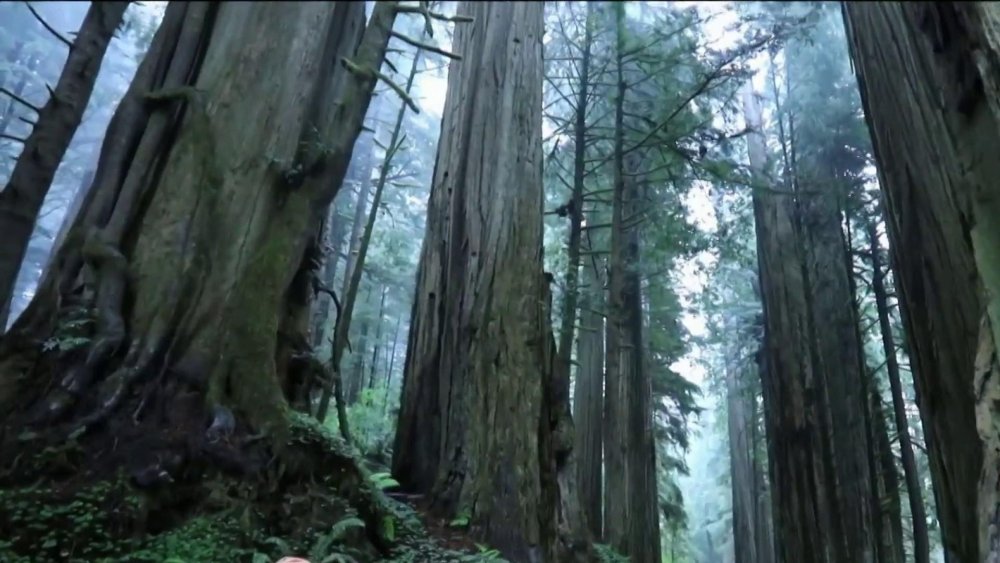Efforts are underway to grow towering new redwood forests, cloned from existing trees, that can sequester massive amounts of carbon.
An old growth redwood forest is nature’s cathedral. Light filters through the giant trees bathing the ferns and mosses below in a primordial green glow.
In the canopy of a 300-foot old-growth coast redwood, the going gets weird. Mosses, lichens, fern mats, even other trees all grow in the canopy soil.
The Brotherhood Tree, a massive redwood in Klamath, California, is host to a complex wildlife habitat and its canopy is full of surprises for those who venture aloft. Bats flutter out into the faces of climbers and hundreds of birds circle territorially above.
For Jake Milarch, who oversees tree propagation at the Archangel Ancient Tree Archive, it’s the perfect place to clip samples of the tree, small enough to fit into the palm of his hand.
“There’s different hormones at the top of these trees,” he says. “What we hope to get when we propagate or clone a champion tree is the exact genetics of that tree. It’s proven itself over time, that it can deal with adverse conditions.”
He’ll take these plant samples back to their Michigan warehouse to clone and grow them.
Archangel Ancient Tree Archive, an organization that advocates reforestation as a solution to global warming, is the brainchild of Jake’s father David, a third-generation tree farmer. A rebel for most of his life, David is on a mission to save the world by planting trees.
Archangel clones champion trees, the biggest and tallest of their species, to preserve their genetics and to combat climate change. On this expedition, the team is cloning The Brotherhood Tree, a tree they estimate to be 1000 years old, starting its life sometime in the Middle Ages.
300 feet is a long way up, at almost 28 stories, it’s a modest skyscraper. Jake Milarch is a certified arborist who started climbing trees at a young age. He gets to the top of the Brotherhood Tree assisted by Damien Carré of Expedition Old Growth, a specialist at adventure tree climbing and a partner of Archangel.
“What they’re doing is what I want to be part of,” Carré says. “We’ve been able to pull off some pretty amazing projects that are doing things for the planet.” Wearing helmets and harnesses, they pull themselves up with ropes.
“We’ll probably take a couple hundred samples,” he says. “Then once we have that basic genetic material captured in our laboratory, there’s really no need to come back to this tree.”
The Milarchs plan to use these clones to supplement and strengthen depleted redwood forests and even migrate them as climate change begins to affect the trees in their natural habitats. They’ve already planted coast redwoods in the Presidio in San Francisco and have plans for these clones to be planted all over the world.
New research published this month in Science Magazine seems to validate the mission of Archangel, suggesting that planting trees could be an effective strategy to help stem climate change. The study recommends planting nearly a billion new hectares of canopy cover around the globe to absorb massive amounts of climate change-fueling carbon — nearly 205 gigatons.
According to a recent study from Humboldt State University and the University of Washington, redwoods sequester more carbon than other forests. Even more so, an old-growth redwood forest supports more biodiversity, sequesters more carbon and has more regenerative properties than younger forests.
The Latin name of a coast redwood is sequoia sempervirens, meaning “forever green” or “forever living,” and these trees are capable of living thousands of years. Redwood trees have bark that is thick and full of tannins that make them resistant to insects and fire, so they have few natural foes.
But they have one major problem. Humans.
“It’s a beautiful wood,” says Steven Meitz, superintendent of Redwood National State Parks, “It’s very resistant to decay and it’s very rot-resistant.”
The coast redwood forests were decimated in the late 1800s by commercial logging to the extent that only 5 percent of the old growth forest remains. He explains that’s the whole reason the park was established.
“Humans were responsible for the reduction in the entire habitat of the coastal redwoods,” Meitz says.
The Redwood National State Parks has partnered with Save the Redwoods League to try and accelerate regeneration of the titanic trees.
Redwoods Rising is that private-public partnership, hoping to restore the old-growth forests that have been destroyed by logging. They clear out the dense mat of wood on the forest floor from the second growth trees and sell that lumber. The proceeds fund more restoration of the redwoods, thinning some so that others may survive.
Their goal is to put the second growth forest on track to become an old grove. Admittedly it’s a long process, but Meitz believes it’s necessary to undo the environmental damage done by humans and hopes this will be a generational project.
“At the rate that we’re going right now, to get to where they’re very thick, it could take thousands of years,” Meitz says.
But he adds optimistically, “We’re hoping to accelerate that and get it down to hundreds of years.”

COMMENTS